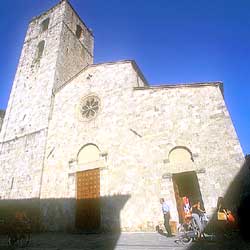|  During medieval times there were three very important pilgrimages: That
going to Jerusalem that going to Santiago di Compostela and finally that
going to the tombs of Peter and Paul in Rome. A thousand years later to
celebrate the Millennium, many pilgrims are treading the ancient path
called Romea or Francigena once again.
During medieval times there were three very important pilgrimages: That
going to Jerusalem that going to Santiago di Compostela and finally that
going to the tombs of Peter and Paul in Rome. A thousand years later to
celebrate the Millennium, many pilgrims are treading the ancient path
called Romea or Francigena once again.
The so called "Francigena" originated in France and connected
northern Europe to the Holy City. After crossing the Padana plains it
reached Lunigiana and then Tuscany through the Cisa pass ("per Alpen
Bardonis Tusciam Ingressus" - Paolo Diacono, Historia Langobardorum,
Book 5, Chpt. 27) otherwise called the pass of Monte Bardone, from "Mons
Longobardorum". Next, to the southern most tip of Liguria in the
province of La spezia, having passed through Pontremoli and Aulla, the
areas of Santo Stefano, Sarzana, and Luni before passing on into the heart
of Tuscia. The low lands of the Val di Magra, crossed by this great 'artery',
was in medieval times a key thoroughfare: infact leading off the Francigena
were numerous secondary roads which lead to the Val di Vera and the coast
upto Genova. Around the Gulf were the ports of Portovenere, Lerici and
S. Maurizio. It was from these ports pilgrims set sail to reach San Jago
di Compostela destination of many ancient Italians. Continuing however
in the direction of Rome one arrived at the first Tuscan Francigenan city
of Lucca.
Continuing on now, beyond the Arno toward Altopascio; a swamp like area
where the "Cavalieri del Tau" controlled the area and hosts
were bound to offer a ferry service across the Arno. Once across the river
the pilgrims continued onto Siena through the Valdelsa arriving at the
monasteries of San Antimo in Valdorcia and San Salvatore. Both ancient
monasteries, the former being of a French order the latter of a German.
Or the pilgrims chose to continue further on to Contigiano (the old Mala
Mulier) arriving soon after at the rocca di Radicofani.
Once across the Lazio border, the Francigena was then directed to the
great volcanoes of: Volsino, Cimino, and Sabatino. Easily distinguishable
for their soft undulating forms and the great lakes, which occupied the
surrounding craters, of Bracciano, Vico, and Bolsena. At this point of
the journey the Holy City was only a few steps away.
Text tratto dal pratico libro tascabile: "Guida alla
Via Francigena 1000 anni dopo" by Claudio e Gianfranco Bracci
- Naturarte, Firenze
In vendita da Febbraio 2000 a £ 15.000
La guida bilingue (italiano-inglese) riporta ogni informazione necessaria
per la percorrenza e l'accoglienza turistica lungo l'itinerario
di pellegrinaggio dalle Alpi a Roma |
|